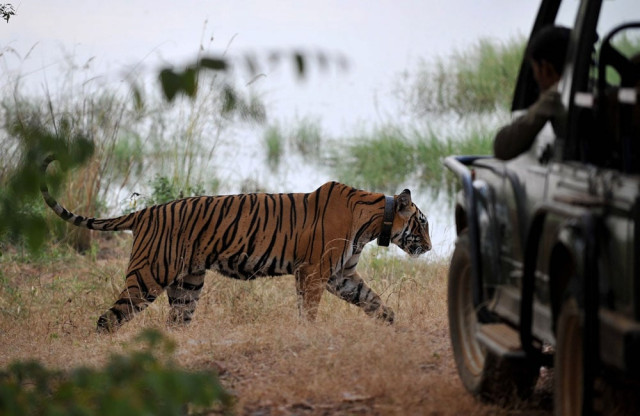Indian public campaigns to send 'killer' tiger home
Forest officials said Ustad had killed four people including the guard

In this photograph taken on October 20, 2010, a tiger is seen during a jungle safari at the Ranthambore National Park in Ranthambore around 200kms from Jaipur. Indian wildlife lovers have on May 19, 2015, launched a campaign to move a tiger back to the wildlife reserve where he grew up after he was placed in captivity following the death of a forest guard. The nine-year-old male, known as Ustad or Master, was taken from the Ranthambore National Park in northwestern India on on May 16, and placed in an enclosure at a zoo 500 kilometres (310 miles) away. PHOTO: AFP
The nine-year-old male, known as Ustad or Master, was taken from the Ranthambore National Park in northwestern India on Saturday and placed in an enclosure at a zoo 500 kilometres (310 miles) away.
Forest officials said Ustad had killed four people including the guard, who was mauled to death near the entrance to the reserve on May 8.
But campaigners say there is no evidence that Ustad, also known as T24, was responsible for the deaths.
Even if he was, they argue, he was only doing what tigers do naturally given that the humans were on his territory.
Thousands have signed an online petition on Change.org calling for the tiger to be returned to its natural habitat, while others have tweeted their support using the hashtag #BringT24back.
"What the hell is happening in #Ranthambhore?? They have shifted tiger T-24 to a zoo from the jungle," one tweeted.
Ustad was the most spotted tiger in Ranthambore, one of the biggest reserves in north India that is spread over 500 square kilometres and home to 60 big cats.
Wildlife expert Ajay Suri said the tiger could have been moved to a less visited part of the reserve.
"There have been similar incidents in Corbett park where a tiger was blamed for killing a guard but they shifted it to the inner area," he told AFP.
"Shifting the tiger from its territory is not the only option."
Suri said Ustad was not a man-eater -- the term given to tigers that deliberately prey on humans for meat.
Wildlife activists have accused local hoteliers of putting pressure on park authorities to remove the tiger.
One has even challenged the move in court, according to the Hindustan Times newspaper.
But Ranthambore's top official on Tuesday defended the decision, citing concern over the safety of visitors and staff.
"After four incidents it becomes our responsibility to ensure such attacks do not happen again," Y.K. Sahu told AFP.
India in January said it had 2,226 tigers, a 30 percent increase in the population from 2010.


















COMMENTS
Comments are moderated and generally will be posted if they are on-topic and not abusive.
For more information, please see our Comments FAQ